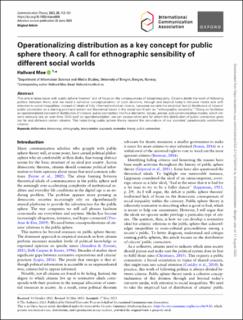| dc.contributor.author | Moe, Hallvard | |
| dc.date.accessioned | 2023-08-15T12:36:30Z | |
| dc.date.available | 2023-08-15T12:36:30Z | |
| dc.date.created | 2023-08-10T14:45:09Z | |
| dc.date.issued | 2023 | |
| dc.identifier.issn | 1050-3293 | |
| dc.identifier.uri | https://hdl.handle.net/11250/3084175 | |
| dc.description.abstract | This article takes issue with public sphere theories’ lack of focus on the consequences of social inequality. Citizens divide the work of following politics between them, and we need a cohesive conceptualization of such divisions, through and beyond today’s intrusive media and with attention to social inequalities. Instead of ideals of fully informed individual citizens, I propose we take the empirical fact of distribution of citizens’ public connection as a starting point and anchor our theoretical ideals in the social world with an “ethnographic sensibility.” Doing so facilitates an operationalized concept of distribution of citizens’ public connection into four elements: issues, arenas, and communicative modes, which citizens variously rely on over time. With such an operationalization, we can assess when and for whom the distribution of public connection goes too far and disfavors certain citizens. This helps bring public sphere theory beyond the conundrum of our societies’ paradoxically uninformed citizens. | en_US |
| dc.language.iso | eng | en_US |
| dc.publisher | Oxford University Press | en_US |
| dc.rights | Navngivelse 4.0 Internasjonal | * |
| dc.rights.uri | http://creativecommons.org/licenses/by/4.0/deed.no | * |
| dc.title | Operationalizing distribution as a key concept for public sphere theory. A call for ethnographic sensibility of different social worlds | en_US |
| dc.type | Journal article | en_US |
| dc.type | Peer reviewed | en_US |
| dc.description.version | publishedVersion | en_US |
| dc.rights.holder | Copyright 2023 The Author(s) | en_US |
| cristin.ispublished | true | |
| cristin.fulltext | original | |
| cristin.qualitycode | 2 | |
| dc.identifier.doi | 10.1093/ct/qtad008 | |
| dc.identifier.cristin | 2166219 | |
| dc.source.journal | Communication Theory | en_US |
| dc.source.pagenumber | 112-121 | en_US |
| dc.subject.nsi | VDP::Medievitenskap og journalistikk: 310 | en_US |
| dc.subject.nsi | VDP::Media studies and journalism: 310 | en_US |
| dc.identifier.citation | Communication Theory. 2023, 33 (2-3), 112-121. | en_US |
| dc.source.volume | 33 | en_US |
| dc.source.issue | 2-3 | en_US |

